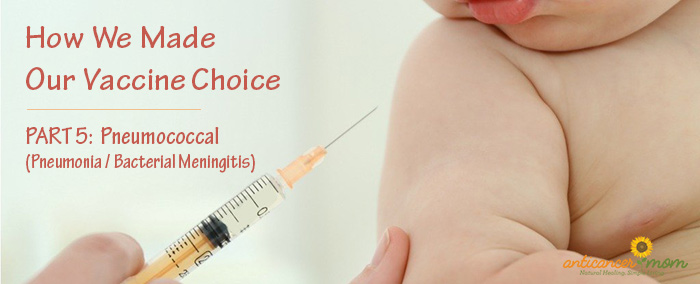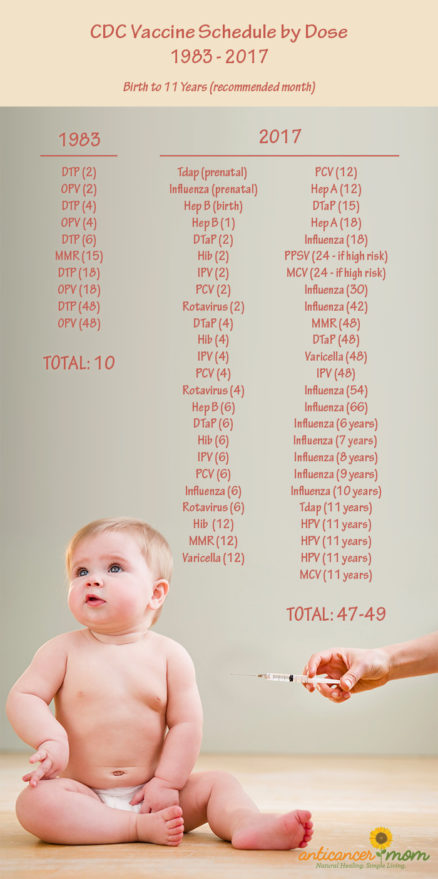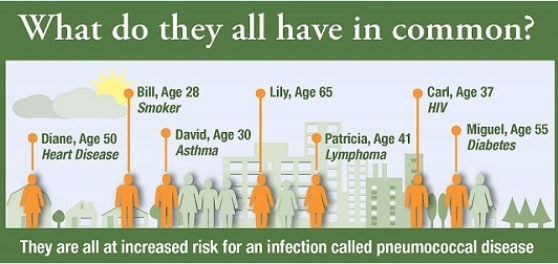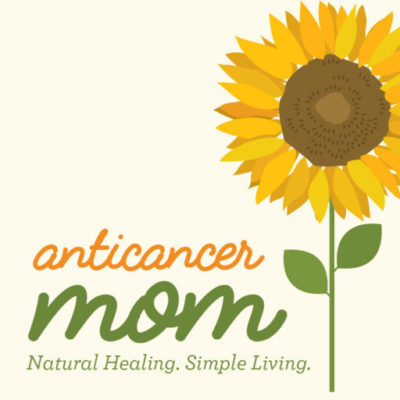
The Pneumococcal (PcV) vaccine is the fifth vaccine in this series and was added to the CDC childhood vaccine schedule in 2000.
This is another one that I did not receive myself since it was not on the 1983 childhood vaccine schedule (see below.) As I researched whether to give this vaccine to my first daughter, there were definitely some convincing reasons to do so. And also many reasons to stay clear of it.
Let’s take a closer look.

This is Part 5 in my vaccine series discussing which vaccines we decided to give to our children and why. You may also want to check out the other posts in this series:
Part 1: Our Vaccine Choice: Risks, Benefits, Responsibility
Part 2: Hepatitis B and Hib Vaccines
Part 3: Diphtheria, Tetanus and Pertussis Vaccine
Pneumococcal Disease
Symptoms:
- sudden onset of fever or chills
- chest pain
- ear pain
- cough
- congestion
- rapid breathing
- purplish or bluish tint in lips
- lethargy
- headache
- seizures
- for bacterial meningitis cases, stiff neck may be present along with confusion and possibly blotchy purple rash
Overview: (CDC)
Streptococcus pneumoniae, the technical name for pneumococcal disease, causes bacterial infection. Pneumococcal bacteria is the most common cause of ear infections in children. The most severe complications but also more rare are pneumococcal bacteremia (bloodstream infection) and bacterial meningitis.
Incubation period is short, only 1-3 days. Symptom length and severity will vary.
Pneumococcal bacteria is present in up to 90% of non-symptomatic carriers. The rates for infection is significantly higher for immunocompromised individuals, people receiving chemotherapy or other immunosuppressant drugs, and the elderly.
According to the CDC, children at greatest risk for invasive pneumococcal disease are those who have sickle cell anemia, immunocompromised, those of certain Native populations, African American, those exposed to second hand smoke at home, and children attending childcare centers (who are 2-3 times more at risk than children in home care.)
Pneumococci bacteria is responsible for 50% of bacterial meningitis cases (where the infection causes inflammation in the meninges of the spinal cord fluid and brain) each year, approximately 3,000-6,000 cases with the majority occurring in the elderly.
Before the vaccine there were about 700 cases annually of bacterial meningitis in the U.S. in children under the age of five. 200 of those children died from complications with the infection.
Pneumococcal disease is not an “outbreak disease,” as in there are not pockets of involvement- and severity can differ from person to person depending on how far the infection has traveled. It has never been a common disease amongst children but does affect the elderly.
Emergency Care:
Care for pneumococcal disease in children will vary depending on the severity of disease progression. If your child experiences prolonged fever and chest cough for over a week and fever is worsening, that is a good sign that you need to seek emergency care and antibiotics orally or intravenously.
In severe cases of infection and bacterial meningitis cases, hospitalization would be needed.
I was surprised at the amount of natural therapies for pneumonia infection available. From essential oils to herbs to homeopathy, I found many options in The Unvaccinated Child: A Treatment Guide for Parents and Caregivers.
Much of the early symptoms of streptococci infection mimic a mild cold, so basic natural home care should begin immediately regardless of official diagnosis or not.
Prevnar 13 Vaccine (PcV)
Ingredients:
- Pc sugar/ diphtheria toxoid complex, (PCV7 serotypes: 4, 6B, 9V, 14, 18C, 19F, 23F plus additional serotypes 1, 3, 5, 6A, 7F and 19A)
- Aluminum – 125 micrograms
- Polysorbate 80 Succinate (buffer)
PcV Vaccine is given in 4 Doses: 2 months, 4 months, 6 months, and between 12 and 15 months.
The original childhood pneumococcal vaccine, put into use in 2000, Prevnar 7 was designed to prevent the most common 7 (out of 90 strains) of pneumococcal bacteria in children. Eventually less common strands became more common and more aggressive, (chasing the mutation) and additional strains were added. In 2010, Prevnar 13 was developed to cover the 13 most common strains of pneumococcal bacteria.
Prevnar has never been studied against a pure control group. The approval studies done used an experimental meningococcal vaccine with no reaction profile instead of using a placebo. In the same study, children were all given the DPT vaccine as well.
VAERS Report:
In 2015, ~4,500 adverse events and 37 deaths from both Prevnar 7 and Prevnar 13 vaccines combined were reported to the Vaccine Adverse Event Reporting System (VAERS). (Remember this reported number is estimated to be 10-100 times less than the actual number and is a volunteer-based reporting system.)
In 2016, these numbers were consistent at ~4,100 adverse events and 38 deaths after vaccination.

CDC infographic targeting at-risk populations for pneumococcal vaccination. (Source: cdc.org)
My Thoughts:
Invasive pneumococcal disease is pretty scary to read about, but there some important things to note when making a decision about whether to give this vaccine or not. There is a very defined population who is most at risk for invasive disease.
If your child falls into any of these categories, you may want to consider this vaccination if it worries you, but I do believe that the type of daily preventative care and home care at the beginning of illness can make a huge difference in your child’s outcome:
- they have sickle cell anemia
- they are immunocompromised,
- they are of certain Native American descent
- they are African American
- they are exposed to secondhand smoke at home
- they attend a childcare center
- they are not breastfed to at least 6 months
**If you choose to give this vaccine, or any vaccine do NOT give Tylenol before or after since it can block the child’s detoxification pathways and lead to brain inflammation. Find an integrative pediatrician to help you with a pain relief that is right for your child.
I would also recommend spacing this vaccine out from others since it is an aluminum containing vaccine. See Dr. Paul Thomas’s alternative schedule HERE.
This vaccine is not without risk. In both 2015 and 2016, more than 30 children were reported to have died after receiving this vaccine (although they most likely received the other 4-6 vaccines for months 2, 4, 6 and 12 at the same visit.)
The CDC states that up to 90% of the population carries pneumococcal bacteria in our nasal passages at one time or another without it causing any problems. When your immune system is weakened, you will be more prone to infection.
Breastfeeding reduces the risk of contracting pneumonia and complications with pneumococcal bacteria significantly. This study from 2013 found that breastfeeding for at least 6 months and preferably beyond one year, reduced the likelihood of invasive pneumococcal disease in children in countries around the world, regardless of socioeconomic status.
This study from 1999 found that non-breastfed or babies who were supplemented with formula were 17 times more likely to be hospitalized for pneumonia than those being breastfed without formula supplementation.
It is important to know that pneumonia does not HAVE to occur just because you came in contact with the bacteria. This was so important in making our decision. Symptoms can show up as only a minor to moderate cold and rarely travels to the lungs, bloodstream, or brain.
Yes, it is scary to read that before the vaccine, 200 children died each year from bacterial pneumococcal meningitis, but I think it is important to point out that we do not know the underlying factors in these cases. Were they breastfed? Were they cared for at home? Were they given an optimal nutrient-dense diet? Did their parents have knowledge of herbal remedies and appropriate home care? Was their gut biome cared for? Since it was the 1990’s and before, probably not.
If pneumonia does develop it is treatable with antibiotics and emergency care if needed, although it is known that pneumococcal disease can be resistant to first-attempt antibiotics due to the overall overprescription of antibiotics we have seen over the past few decades.
Our Decision:
Ultimately, our decision NOT to vaccinate with the PcV vaccine was due to the knowledge that we were not in a high-risk category for complication from pneumococcal infection. We were committed to exclusive breastfeeding, childcare at home (my husband and I worked opposite shifts,) and proper supplementation of probiotics through diet and supplements.
Our plan of action for pneumococcal infection is to monitor our child carefully for ongoing fever, cough, chest congestion/ breathing problems, lethargy, and especially stiff neck and headache in case of rare meningitis infection. At onset of mild cold symptoms we would begin home care through necessary supplements, probiotics, Vitamin D and much needed rest to allow her body to recover and also begin proper aspiration of mucous (via NoseFrida- my favorite), to avoid infection traveling to her lungs.
We would not hesitate to seek emergency care immediately for regular or IV antibiotics if symptoms of meningitis were present.
Sources Cited:
https://www.cdc.gov/vaccines/pubs/pinkbook/pneumo.html
https://www.merckmanuals.com/home/quick-facts-brain,-spinal-cord,-and-nerve-disorders/meningitis/bacterial-meningitis
https://vaers.hhs.gov/data.html
https://www.ncbi.nlm.nih.gov/pmc/articles/PMC3847465/
https://www.ncbi.nlm.nih.gov/pmc/articles/PMC27869/



I Cortney. I was just diagnosed with breast cancer. I don’t know the stage yet. I just had the biopsy last week. I came across your site because chemo and radiation is just a no for me. I was wondering about your vitamin protocol. I got Bill Henderson’s book Friday and already ordered all the supplements and essiac tea. I have a question about the vitamin C. I have had 2 rounds of IV Vitamin C and they were expensive and time consuming. The doctor that administers it is over an hour away. That keeps me out of the house for close to 6 hours. I saw Chris Wark’s article on liposomal vit C and doing the tolerance test. Just wondering how many times a day you dosed with Vit C. Did you do the tolerance test? How much did you take at first? For your smoothie, did you add the kelp because of the iodine? I don’t like avocado, but I could learn to tolerate it if necessary. Do you think I do need it? I have a juicer. Do you think I should juice the vegetables once a day instead of a smoothie? I do eat a gargantuan bowl of salad at lunch. So I am getting fiber when I eat the salad. Did you use balsamic vinegar or just apple cider. I can tolerate the Budwig. I mixed the cottage cheese and flax first and then I added walnuts, blueberries, and blackberries. Sorry for all the questions. Any reply will be appreciated.
Hi S 🙂 It’s tough getting that diagnosis, but I am happy to hear you are proactive and looking for solutions! I never did IV vitamin C and the only amount I took was with the “Hearts Plus” product along with the green tea extract. I am a fan of the tolerance testing with Vitamin C and the liposomal (from what I know and what I have on hand if my unvaxxed kids ever got whooping cough) is what I use. You can see the brand we use in my Flu post from this year. I added the kelp because in Ann Wigmore’s Hippocrates soup she used for cancer patients. Iodine is a plus. I only used half an avocado in most of my smoothies so it wasn’t too noticeable and made it less liquidy. I actually only drank smoothies during my treatment. It’s funny, but I couldn’t stand the wasting involved with juicing! Perhaps that’s just me though! 😉 For many protocols though, juicing is essential so take note of that. I used balsamic occasionally but there are so many more health benefits and probiotics with the ACV. Good you like the Budwig. My new guide has several recipes for changing things up if you get tired. 🙂 All the best to you!
Thanks for your reply. I found out it is stage 1 and localized to one breast. I will have it removed because it was found in 3 spots on the one. I will do reconstruction. MRI I had showed there was no axillary involvement so I am hoping that when it is gone, it will be gone. I have cycled between vegetarianism and veganism over the last 3 years. Still hard to transition to completely raw although I found a great raw cacao snack without added sugar from Living Intentions.
Fascinating. Great post! Your kids aren’t old enough yet, but how do you feel about the HPV vaccine, Cortney?
A big fat NO! So many other options for prevention, and it is DANGEROUS, rushed and full of garbage science to get it to market. No way! Entire website devoted to teenagers dying and getting incredibly sick after their vaccine: http://www.mygardasilstory.com.au/